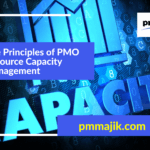The most important aspect of a project is the people. Without people (resource), then it will be impossible to complete the project. That is why project resource management is very important.
Resource management definition
Resource management is the process in which you plan, schedule and allocate your resources to achieve maximum efficiency on your project. Resources can include physical materials, software and people.
Why is it needed?
The ultimate goal of your project will be its successful completion in the most efficient way possible, in other words, doing more with less, and reducing waste.
Such is its importance, some organisations recruit a Resource Manager who is responsible allocating resources, as opposed to the Project Manager who creates and assigns the tasks needed to complete the project.
Advantages of resource management
Resource management provides transparency, allowing other teams to clearly see your team’s workload and avoiding overallocation and dependency.
Having an understanding of your resources at the beginning of the project and planning how they will be used helps the manager see where any problems or gaps may arise before time, allowing a plan to be put into place to solve them.
Return on Investment can be easily measured by having a sound idea of what resources are needed to undertake a forthcoming project.
If lack of resources means that the project fails, resource management allows you to show that you did what you could with the resources available.
Resource management techniques
There are three techniques that you can use to put resource management into practice.
Resource allocation
Helping you to get the most from the resources that you have available, resource allocation involves completing your project with the resources that you have, in the most efficient way possible. Reports are often used to aid transparency.
Resource levelling
If you have resources in your organisation that are under or inefficiently used, then you should identify those and use them to your advantage. Do your staff have experience in areas of the project other than the area they are working on? If so, utilise their skill set!
Resource forecasting
A vital aspect of the planning stage, resource forecasting enables a project manager to identify the scope of the project, any possible constraints and potential extra costs and risks. Having a good understanding of the project life cycle and the resources available will assist in accurate forecasting.
Determining demand and supply to establish project resource profile
A key economic concept, demand identifies how much of your product is desired by the consumer, whereas supply determines how much you can produce.
Understanding how many resources will be needed to meet demand versus how many resources are currently available underpins resource demand planning.
To understand demand and supply a resource planning process should be put in place.
Establish the supply
Capture details of the resources available. You may want to group them into skill sets and locations and then straight-line capacity over 12 months, giving a high-level view of the supply available.
Establish demand
A demand profile for the same 12-month period should be completed from the template used to identify the supply baseline. Typically, this will show a peak which will ramp down near to completion.
Once submission for the project has been received, an aggregated view of demand on a month by month basis can be built.
Compare demand to supply
The demand summary should be compared to the supply baseline to identify areas where demand exceeds supply. Work can then be undertaken to see if you can smooth demand.
Monthly refresh
The project should provide updated demand templates each month. Processes should be established to gather changes in the supply baseline – such as new joiners or leavers – and demand should be compared to supply to identify contentions.
You can find more details in the article, Guide to Manual Project Management Resource Process.
Input into the budget process
When you have determined the resource demand to complete the project, then you can calculate the budget. This is achieved by calculating the cost of each resource for the period they are required.
The ideal situation is to use the actual cost of each resource. However, this information may not be available as it can be sensitive. If this is the case, an organisation may have generic fully loaded resource costs based on role / position, etc.
For each resource calculate the cost. When all of the costs have been calculated, these can be input into the overall budget.
Combined Resource / Budget Refresh
If possible, construct your resource templates so that they also allow the addition of costs. This means that as you refresh your resource forecast, the cost element will also be refreshed.
Summary
A project requires people to execute the work. Constructing a robust resource plan that shows resource demand on a month by month base is critical for managing a project.






